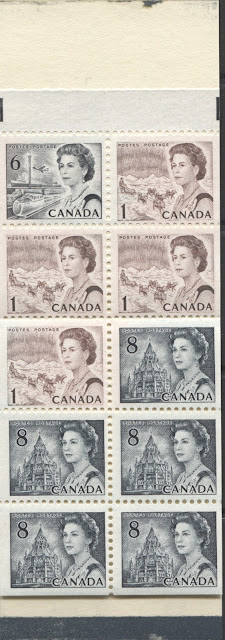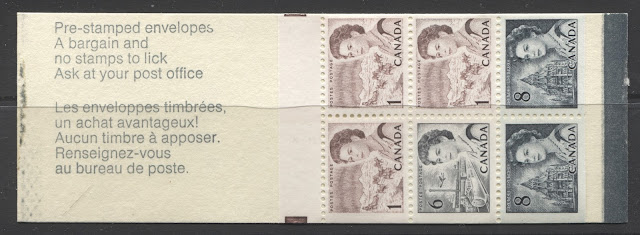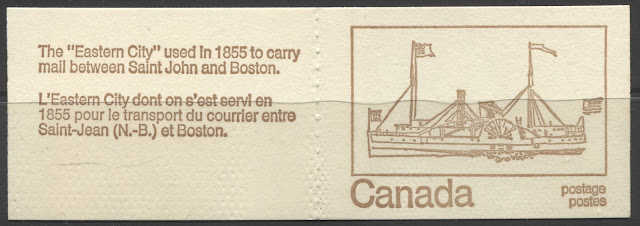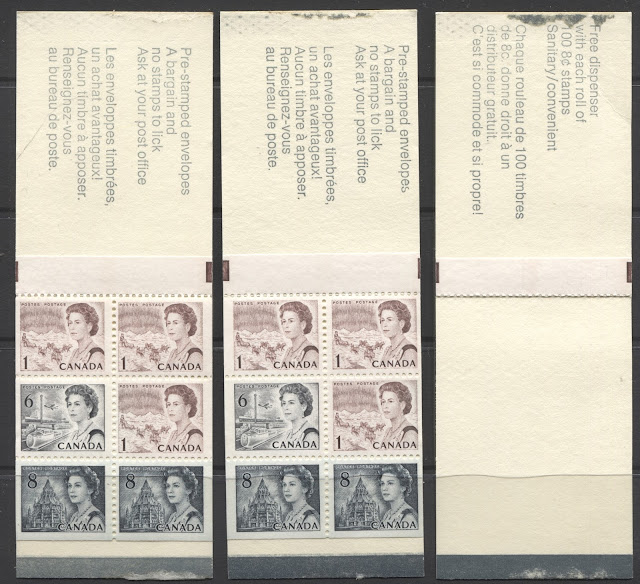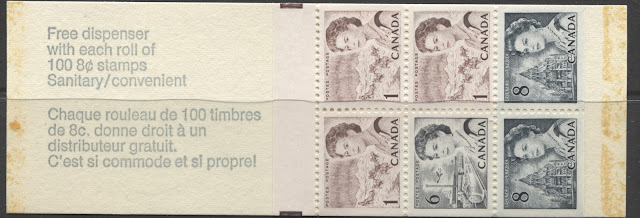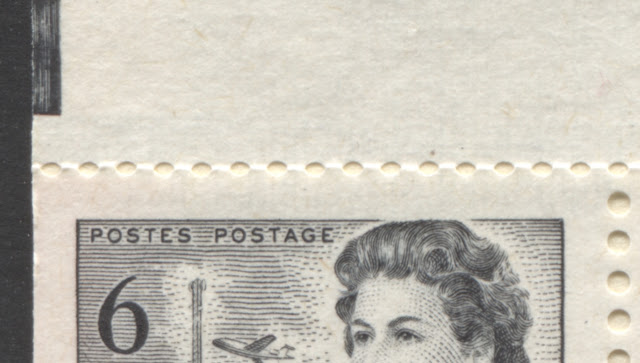Today's post will be the first of the New Year, and will deal with the last three integral booklets that were printed by the British American Bank Note Company, for this issue, being the 25c, 50c and $1 booklets that contained the 8c slate Parliamentary Library together with various quantities of the 6c transportation and 1c Northern Lights and Dog team. This combination of stamps allowed the user to make up the 8c domestic rate, the 6c third class rate, the 10c U.S rate, and 15c airmail rate. These later two rates would have been the main use for the 1c stamps that were included in each booklet. The experiment conducted in Toronto with the 50c booklets was a clear success, and so it was decided to make 50c booklets a permanent addition to Canada Post's repertoire.
The main reason why I chose to deal with these booklets in one post is their complexity. In addition to the usual complications arising from paper fluorescence, cover fluorescence and counting marks, there are four other factors that increase the complexity of these booklets significantly:
As you can seem the tagging is a bright green, but it is not of even strength. This is why it is classified as OP-4 rather than OP-2, as this characteristic is common of the OP-4 tagging found in early 1972. This OP-4 tagging shows no evidence of migrating either.
The OP-2 tagging which is found on the last printings of these booklets is always 3 mm in width and is a solid, even, bright greenish yellow colour. An example is shown below:
The main reason why I chose to deal with these booklets in one post is their complexity. In addition to the usual complications arising from paper fluorescence, cover fluorescence and counting marks, there are four other factors that increase the complexity of these booklets significantly:
- Different cover seals: As we shall see, both the 25c and 50c booklets were issued with both a clear sealing strip and a black sealing strip. Both the McCann and Unitrade catalogues give explicit recognition to this. But what they do not list are the differences that can be found in the sealing strips themselves, which this post will get into in detail.
- Different cover designs: The first printings of the 25c booklets, and all of the $1 booklets produced, were issued with the plain cover types introduced in 1969. However, starting in 1972, a series of 10 different cover designs were introduced for each of the 25c and 50c booklets, resulting in 10 times as many collectible varieties on these booklets. I have actually seen variations in the quality of printing on these 10 cover designs, so that the number of potential varieties is even higher than this.
- OP-2 and OP-4 Ottawa tagging: The 25c booklet exists with both OP-2 and OP-4 Ottawa Tagging, and in addition, the tagging can be found in both 3 mm and 4 mm widths. The $1 and 50c booklets supposedly only exist either untagged or with OP-4 tagging. However, given that the 50c booklets were not issued until August 1972, I think it is quite possible that they may exist with OP-2 tagging as well, though none have been reported, as yet. Within each tagging type, there are also variations in the colour of the tagging under UV Light.
- Ribbed and smooth papers: In addition to the normal smooth paper, found on the earlier booklets, several of these booklets exist printed on wove paper that shows a clear vertical ribbing on the face.
All three of these booklets were issued only with PVA gum, which should make the issue of gum, a non-issue. However in practice, as we shall see, there are differences in the sheen, and colour of the PVA gum found on these as well.
McCann notes in his catalogue that there are a large number of non-constant inking flaws to be found on all of these booklets. This post will not focus on these, but will identify the two constant flaws that are known on the 25c booklets, being the "airplane in sky" and "mole on forehead", which are found in the second stamp in the second row.
The basic 25c, 50c and $1 panes are shown below:
25c pane consisting of 2 x 8c + 1 x 6c + 3 x 1c
50c pane consisting of 5 x 8c + 6c + 4 x 1c.
$1 pane consisting of 11 x 8c + 6c x 1 + 6 x 1c.
The remainder of this post will discuss each of these booklets in greater detail.
25c Booklets - First Covers
On December 30, 1971 the first 25c booklets containing 2 x 8c slate, one 6c black and three 1c brown were issued. The same plain 25c boxed "Canada" design that was introduced for the 7c booklets was used again, the two different bilingual cover slogans "free dispenser with each roll of 100 8c stamps - sanitary/convenient", and "pre-stamped envelopes - a bargain and no stamps to lick. Ask at your post office" were used again. All of these booklets had a black sealing strip, but most of these covers exist printed in both a coarse font and a fine font. A total of 7,200,000 booklets were issued. According to McCann, the panes were comb perforated 12.4 x 11.9, even though Unitrade lists them as 12.5 x 12.
Cover Types - Basic Designs
"Pre-stamped" cover in the coarse font
"Free Dispenser" cover in the coarse font.
Unfortunately, I do not have an example of the fine font in stock at the moment. However, I will be sure to add an example in a subsequent update to this post when I obtain one.
Cover Stocks and Fluorescence
All of the booklets of this design that I have looked at are all printed in dimpled, cream coloured stock, which gives a dull fluorescent reaction under UV light.
Paper Types - Smooth and Vertically Ribbed Paper
McCann identifies these booklets as having been printed on two basic types of paper, ignoring the fluorescence: a smooth wove, showing no ribbing, and a wove that shows clear vertical ribbing on the face. Both types of paper often have dozens or hundreds of tiny dimples, that show up as depressions on the printed side and as raised bumps on the gum, as seen from the back of the stamps.
Gum
The gum on these booklets is quite white compared to the cream coloured gum on the later 25c booklets with pictorial covers and the 50c booklets. It is quite shiny having a semi-gloss sheen. However, it lacks the greenish tinge of the gum on the $1 booklet.
Paper Fluorescence
The panes contained within these booklets are found on paper exhibiting four basic grades of fluorescence:
- Low fluorescence
- Medium fluorescence
- High fluorescence
- Hibrite
Except for hibrite, all of these papers contain fluorescent fibres of varying brightness and densities, that contribute to the overall fluorescence. In addition, under UV light, you can also see little brown flecks in the paper, which are actually woodpulp fibres. The density of these fibres varies.
In theory, all four of these grades should exist with both cover types, and with both smooth and vertical ribbed papers. However, There are some combinations of covers and paper textures that are conspicuously missing from McCann's detailed listings. None of the type II covers are listed on low fluorescent paper for example. Interestingly, none of these booklets are listed to exist with either dull or dead paper, as one might expect.
Sealing Strips
Even though these booklets are only known with black sealing strips, there are some variations to be found in the width of the strips, and it should be noted that the strips are generally quite a bit narrower than the black strips found on the other 25c booklets and 50c booklets.
The scan below shows an example of a very narrow sealing strip, together with a much wider one:
The wide 5 mm strip is shown on the left booklet, while the narrow 3 mm strip is shown on the right. Notice how there is no trace of adhesive on the left booklet, which suggests that at least some of these were never sealed.
Tagging
The only type of tagging that McCann and Unitrade list for these booklets is OP-4, which makes sense, as they were replaced by the 10 cover designs by the time that the more stable OP-2 tagging was introduced in late 1972. However, again, not all cover type and paper combinations are listed as occurring with this tagging. It seems for instance that all of the tagged booklets have coarse font covers, and with one exception, all are printed on smooth paper, that is either medium or high fluorescent.
Rubber Stamped Cover
McCann lists the Type 1 cover, printed in the coarse font, with a high fluorescent, smooth pane, as existing with a rubber stamped slogan on the cover, that reads "2 booklets of". No other cover or paper combinations are listed with this handstamp, though it is possible that others could exist.
Bringing It All Together - Master Listing
McCann's booklet catalogue does a fairly good job taking all the above variables and parsing them to produce a listing of 25 different booklets for these covers:
- Type 1 on low fluorescent paper is listed with both coarse and fine covers, as well as smooth and vertically ribbed paper, for both types, for a total of 4 different booklets (BK69a-d).
- Type 1 on medium fluorescent paper is listed for both coarse and fine covers, with the coarse cover being listed with smooth and vertically ribbed papers (BK69e-g).
- Type 1 on high fluorescent paper is listed for both coarse and fine covers, with the fine cover being listed with smooth and vertically ribbed papers (BK69h-j).
- Type 1 on hibrite paper is listed with both fine and coarse covers, on smooth paper only (BK69k-l).
- Type 1 with coarse font cover, is listed on both medium and high fluorescent smooth paper, and OP-4 tagging (BK69m-n).
- Type II with both coarse and fine covers is listed on both vertically ribbed and smooth medium fluorescent paper (BK69o-r).
- Type II with coarse cover is listed with both smooth and ribbed high fluorescent paper, while the fine cover is only listed on high fluorescent smooth paper (BK69s-u).
- Type II with coarse cover on smooth, medium fluorescent paper, and OP-4 tagging is listed as BK69v.
- Type II with coarse cover, on both smooth and vertically ribbed high fluorescent paper is listed as BK69w and BK69x.
- The type 1 booklet with the rubber stamped slogan is listed as BK69y.
Of course, every single booklet listed here can be found with a counting mark on every 50th booklet.
The following represents booklets that should, or could exist, but are not listed either by McCann or Unitrade:
- Type 1 fine font, on medium fluorescent paper, with vertical ribbing.
- Type 1 coarse font, on high fluorescent paper, with vertical ribbing.
- Type 1 fine and coarse font on hibrite paper, with vertical ribbing.
- Type 1 fine and coarse font, smooth and vertical ribbed low fluorescent paper with OP-4 tagging.
- Type 1 fine font, smooth and ribbed medium fluorescent paper with OP-4 tagging.
- Type 1 coarse font, ribbed medium fluorescent paper with OP-4 tagging.
- Type 1 fine font, smooth and ribbed, high fluorescent paper, with OP-4 tagging.
- Type 1 coarse font, ribbed high fluorescent paper, with OP-4 tagging.
- Type 1 fine and coarse fonts, on hibrite vertically ribbed paper, with and without OP-4 tagging.
- Type 1 fine and coarse fonts, on smooth hibrite paper, with Op-4 tagging.
- Type II fine and coarse covers, on smooth and vertically wove low fluorescent paper, both with and without OP-4 tagging.
- Type II fine cover, on smooth and vertically wove medium fluorescent paper with OP-4 tagging.
- Type II coarse cover, on vertically ribbed medium fluorescent paper with OP-4 tagging.
- Type II fine cover, on vertically ribbed, high fluorescent paper.
- Type II fine cover, on both vertically ribbed and smooth high fluorescent paper, and OP-4 tagging.
25c Booklets - 10 Different Cover Designs
In late 1972, it was decided to replace the plain cover design with 10 different cover designs, featuring historic miletones or innovations in Canada's postal system. A point of confusion, that is not clarified by either McCann, or Unitrade is that the two slogans, which were previously found on the back cover of these booklets are now found on the inside front cover, and are only found for five of the 10 cover designs for each slogan, and not for all 10, as some collectors might assume.
The 10 cover designs, and inside cover slogans are as follows:
- Canadian Post Office in 1816 - "free dispenser".
- Stagecoach from 1820 - "pre-stamped".
- Eastern City from 1855 - "pre-stamped".
- Country Postman from 1900 - "pre-stamped'.
- Motor Car from 1910 - "pre-stamped".
- Ford Model "T" from 1914 - "pre-stamped".
- Curtiss JN4 Aircraft from 1918 - "free dispenser".
- Royal Mail Truck from 1921 "free dispenser".
- Motorcycle from 1923 "free dispenser".
- Royal Mail Wagon from 1926 - "free dispenser".
Now, it is possible that some booklets could exist in which the wrong cover design is associated with a particular slogan. However, no such errors have been reported to exist as yet. All 10 cover designs are found with both black and clear sealing strips, though not all of these are found on some of the paper types. Furthermore, some variations in both the black and clear strips have been found, which are not described in either Catalogue, though McCann does point out the fact that the colour of the clear sealing strips does vary from almost invisible to dark brown, which suggests that different sealing compounds were used to seal the booklets. The quantity of these booklets is not known, as they were included in the total print figure of 7,200,000 that was given by McCann for all of the 25c booklets containing the 8c.
Cover Designs - Basic Types - Inside Covers
Free Dispenser inside cover
"Pre-stamped" inside cover
Cover Designs - Basic Types - Front and Back
Post office cover
Stagecoach cover
Eastern City cover
Country postman cover
Motor car cover
Model T cover
Curtiss JN 4 cover
Mail truck cover
Motorcycle cover
Royal Mail Wagon cover
Cover Designs - Varieties
A number of varieties can be found on these covers. Most involve broken letters or incomplete designs. Broken letters can occur on either the inside cover slogans, or on the back covers. Breaks can occur either on the frames of the front covers, or on elements of the design itself.
Below is an example of broken letters on the inside front cover slogan:
The booklet cover on the left is normal, while the one on the right shows a broken "S" in "envelopes".
The scans below show some of the other types of varieties that can occur on these booklets:
Incomplete "1921" - an example of defective lettering on a back cover.
Wedge in spine at upper left and overinking of "Postage and Postes".
First "A" of "Canada" truncated at bottom.
Cover Stock
I have found two different basic card stocks used for the covers of this booklet:
- A dimpled cream coloured stock that has an otherwise smooth finish.
- A cream coloured stock that has a somewhat rough surface on the outside cover, and shows faint horizontal ribbing on the inside cover.
The scan below show both types clearly:
The dimpled stock. Note the tiny depressions on the back cover. I have found that the dimpled stock seems to be found mostly on the booklets with black sealing strips.
The rough stock. Note the absence of dimples. This stock seems to occur mostly on the booklets with clear sealing strip.
Cover Fluorescence
An aspect of these booklets that has been completely ignored by both McCann and Unitrade is the fluorescence of the card stock itself. Most of the covers are a dull fluorescent stock that does not look significantly different under UV as compared to normal light. However, some of the covers can be found on a stock which exhibits a mottled low fluorescence as shown in the following picture:
It is difficult to see from this picture, but if you look carefully you will see that the cover on the right has a mottled appearance whereas the one on the left appears normal. The mottling is alternate low and dull fluorescent spots, while the normal cover is just a dull fluorescent cream - the same as in normal light.
Cover Seals - Black Sealing Strips
The black sealing strip consists of a black strip printed on the inside back cover that is usually between 5 and 6 mm wide. A few spots of clear adhesive is applied to the inside front cover to form the seal. Consequently, when these booklets are opened, some black transfer from the strip winds up on the inside front cover, and some damage to the strip results, as shown in the scan of the inside front cover.
The scan below shows three different widths of sealing strip: 5 mm on the left, 5.5 mm in the middle and 6 mm on the right.
As you can see the colour of the sealing strips also varies from a solid black to a much greyer black.
Another variety that can be found with the black sealing strips are breaks in the printing of the strip, such as that shown below:
Note the gap of 1.5 mm about 2.5 mm up from the bottom on the right. Close examination reveals that this is a gap in the printing of the black strip, and not damage caused by the opening of the booklet.
Some of the black sealing strips can be found with no adhesive at all on either the strip, or the inside front cover, which suggests that at least some of these booklets were never actually sealed. The scan below shows an example of one such booklet:
Notice how there is no trace of any adhesive on either the inside front or back covers.
Cover Seals - Clear Sealing Strips
The clear sealing strip used on this booklet consisted of a single band of adhesive that was applied directly to the inside back cover. After all these years, it usually appears deep yellow in colour. The width of the strips appears to vary slightly again, from 5 mm to 6.5 mm wide, but the variation is harder to measure accurately, as the edges of the strip are not usually smooth in the way that they are for the black strips. The scan below shows an example of the clear sealing strip:
Here are two different examples of the strip in which one is 5.5 mm wide and the other is 6.5 mm wide:
The difference in appearance between the narrower strip on the right, which is the one normally seen, and the wider one on the left is quite striking.
Some booklets also had a clear sealing strip that was clearly applied to both the inside front, and the inside back cover, as evidenced by the even, solid band of adhesive that appears on both the inside front and inside back covers. The scan below shows an example of this type of sealing strip:
Paper Types
Neither McCann, nor Unitrade list anything other than smooth wove paper for these booklets. However, I have come across several booklets that were printed on a clear vertical ribbed paper. The scan below shows the clear difference between these two papers:
Smooth paper.
Ribbed paper. The ribbing is hard to see in a scan, but if you look in the upper margin of the 6c stamp, you can just make it out. Here is a closer scan of the 6c:
In the upper margin, the ribbing shows up as vertical lines that are slightly darker than the rest of the paper. In practice, it is much easier to see in the flesh than it is here.
In the upper margin, the ribbing shows up as vertical lines that are slightly darker than the rest of the paper. In practice, it is much easier to see in the flesh than it is here.
In terms of fluorescence, I have noticed that the ribbed papers I looked at seem to be towards the dull and low fluorescent end of the spectrum. However, I expect that with careful study you will probably discover that both types of paper can be found with the full range of paper fluorescence.
Paper Fluorescence
A wider spectrum of paper fluorescence is found on these booklets than on the previous plain cover booklets, which includes:
- Dead paper
- Dull fluorescent
- Low fluorescent
- Medium fluorescent
- High fluorescent
- Hibrite
My comments made in the same section of the earlier 25c booklets in regards to fluorescent fibres and brownish woodpulp fibres applies to these booklets also.
Gum Types
The PVA gum used on these booklets is an off-white colour and has a satin sheen. It is quite cream compared to the gum found on the previous plain-cover booklets.
Tagging
These booklets are found untagged, and with both OP4 and OP-2 tagging. The OP-2 tagging is only found on the booklets with the clear sealing strip, whereas the OP-4 tagging can be found on booklets with both the black and clear sealing strips. I believe that what Unitrade and Mc Cann often refer to as OP-4 tagging may actually be OP-2. For example, here is a scan of a black sealing strip booklet, with 4 mm tagging on high fluorescent paper:
The tagging glows a pale green under UV, and is described by Unitrade and McCann as being OP-4 tagging. However, I did not find a single instance of contamination of either the booklet cover, or the back of the pane from migration of the tagging, which should occur with OP-4 tagging. However, for the purposes of this post, I will accept the classification of this tagging as OP-4.
The OP-4 also exists in 3 mm format, and is found on some of the early printings of the booklets with the clear sealing strip. An example is shown below:
As you can seem the tagging is a bright green, but it is not of even strength. This is why it is classified as OP-4 rather than OP-2, as this characteristic is common of the OP-4 tagging found in early 1972. This OP-4 tagging shows no evidence of migrating either.
The OP-2 tagging which is found on the last printings of these booklets is always 3 mm in width and is a solid, even, bright greenish yellow colour. An example is shown below:
You can see hopefully, how much more even and bright the colour is as compared to the other two OP-4 tags. There is much more yellow in the OP-2 tagging, and much less green, whereas the OP-4 tagging looks predominantly green.
Constant Varieties
There are two constant varieties that occur on these booklets, and both are found on the second 1c stamp in the second row of affected booklets, though they do not usually occur together on the same stamp. The first of these is the "airplane in sky", which is shown below:
The second of these varieties is called the "mole on forehead, and is pretty self explanatory. I do not have an example to show here at the moment, but will add a scan, as soon as I obtain a suitable example.
Bringing It All Together
McCann's booklet catalogue takes all the above variations and lists 16 basic types of booklet for each cover, plus three varieties for each cover, two of which are missing tag bars at either left or right, and one of which is the "airplane in sky" variety. The following summarizes what is listed:
- The black sealing strips, untagged are listed on dull fluorescent, low fluorescent, medium fluorescent, high fluorescent and hibrite paper (BK69aa-ae).
- The black sealing strips, tagged with OP-4 tagging, are listed on low fluorescent, medium fluorescent paper and high fluorescent paper (BK69af-ah).
- The clear sealing strips untagged are listed on medium fluorescent, high fluorescent and hibrite papers (BK69ai-ak).
- The clear sealing strips with OP-2 tagging are listed on dead, dull fluorescent, low fluorescent, medium fluorescent and high fluorescent papers (BK69al-ap).
- The "airplane in sky" variety is listed as BK69aq. It can exist on any of the booklets. Given that there are 16 listed booklets, plus 7 that are not listed that should exist, and 10 covers of each, there are potentially 230 collectible booklets that have this variety.
- The "dot on forehead", which is documented to exist on the same stamp as the "airplane in sky" is not assigned a number by McCann, and should exist on the same number of booklets as the airplane in sky.
- Booklets with clear seals missing a tag bar at left are listed as BK69ar, while those missing the tag bar at the right are listed as BK69as. Again, these can exist on any tagged booklet with clear seal. Given that McCann lists 5 basic types of paper and the HB paper should exist for a sixth type, and each should exist with 10 covers, there should be up to 60 collectible booklets of each of these catalogue numbers.
Of course, every single booklet listed here can be found with a counting mark on every 50th booklet.
The following represents booklets which should exist, or could exist, but are not listed:
- Black sealing strip, tagged with OP-4 tagging on either dead paper, dull fluorescent paper or hibrite paper.
- Black sealing strip untagged on dead paper.
- Clear sealing strip untagged on dead, or dull fluorescent paper.
- Clear sealing strip, with OP-2 tagging on hibrite paper.
The complexity of these booklets expands considerably if we factor in the possibility of both 3 mm and 4 mm OP-4 tagging on those booklets that exist with OP-4, as well as the possibility of nearly all papers existing as both smooth and vertically ribbed versions.
50c Booklets - 10 Different Cover Designs
These booklets were issued starting in August 1972, and featured the same to pictorial cover designs as the 25c booklets, except that instead of being printed in brown on cream coloured stock, they are printed in blue on cream. Unlike the 25c booklets, there are no slogans on the inside cover, which simplifies the booklet considerably
The booklets included five 8c slate library, one 6c black transportation and four 1c brown Northern Lights and dogsled team - so not simply 2 times the number of stamps in the 25c booklets. Instead of including two 6c stamps, an extra 8c stamp and two fewer 1c stamps were included. The exact issue quantity is not known. As with the other booklets, the perforation was 12.4 x 11.9 comb. Interestingly, both black and clear seals are found on these booklets, even though they were issued late in 1972. Only OP-4 tagging is known on these booklets, which is strange given that they were issued late in 1972. It would seem that the tagging should be OP-2 at this point.
Paper Types
Neither McCann, nor Unitrade specify whether or not the paper used was smooth, or ribbed, which leaves the reader of these sources to assume that the booklets were printed on smooth paper. All of the booklets that I have examined are printed on vertically ribbed paper. However, I expect that both smooth and vertically ribbed papers exist for both grades of fluorescence.
Paper Fluorescence
The paper used to print the panes of these booklets are listed as having either low or medium fluorescence. This is consistent with what is usually found from 1972-1974, but that being said, there are other stamps from this period that have been found on dull paper, and others on hibrite paper. So it would stand to reason that these panes could exist on these other grades of fluorescence as well, even if they have not been reported as yet.
Cover Stocks and Fluorescence
All of my comments regarding cover stock and cover fluorescence that I made for the 25c booklets with pictorial covers should apply here as well. I have found all of these booklets on both the dimpled stock and the rough stock. I have not found a wide range of fluorescence in the covers, but I have only examined a very limited number of booklets, and so I think that it is possible that there may be at least three of four possible grades of fluorescence on the covers of these booklets as well.
Sealing Strips
I would expect that both the black sealing strips, and the clear sealing strips that can be found on these booklets should exhibit the same degree of variation that we saw on the 25c booklets.
Gum
The PVA gum on these booklets, like the 25c booklet is an off-white colour and has a satin sheen, bordering on a semi-gloss sheen.
Bringing It All Together
Both Unitrade and McCann list six basic booklets for each cover, while McCann lists a "left tag bar missing variety:
- The black sealing strips, untagged are listed on both low and medium fluorescent paper (BK71a-71b).
- The black sealing strip with OP-4 tagging is listed only on medium fluorescent paper (BK71d).
- The clear sealing strips, untagged are listed on both low and medium fluorescent paper (BK71c, and BK71f).
- The clear sealing strip with OP-4 tagging is listed only on medium fluorescent paper (BK71e).
- The "left tag bar missing" is listed as BK71g, but this can exist on any of the six basic types. Assuming that none of the four possible, but unlisted types exist, and there are 10 different covers, that makes for at least 60 possible booklets, and as many as 100 if the unlisted, but possible paper and tag variations described below actually exist.
Of course, every single booklet listed here can be found with a counting mark on every 50th booklet.
The following represents booklets that could, or should exist, but are not listed by either Unitrade or McCann:
- The clear sealing strips on low or medium fluorescent paper with OP-2 tagging.
- The black sealing strip with OP-4 tagging on low fluorescent paper.
- The clear sealing strip with OP-4 tagging on low fluorescent paper.
The above listings do not take into account the possibility that there may be both smooth and vertical ribbed papers that could exist for every listed variety as well.
$1 Booklets
This booklet was issued on December 30, 1971 and consisted of 11 8c slate library stamps, one 6c black transportation and six 1c brown Northern Lights and Dogsled team stamps, making up the total face value of $1. Like the other panes discussed here it was comb perforated 12.4 x 11.9. The total quantity of booklets issued is unknown. The booklet was issued with only the plain cover type that was used for the earlier 7c booklet, except that the colour is slate on cream, rather than dark green on yellow. Only one cover type is known, which makes it a much simpler booklet.
The front and back cover of this booklet is shown below:
Gum
The gum used on this booklet is a thicker and shiner PVA gum than is found on any other the other booklets. It is a greenish white colour and has a semi-gloss sheen.
Paper Types
Again, neither Unitrade, nor McCann make any mention at all of whether the paper for these booklets is smooth or vertically ribbed. I have only one booklet in stock at present, and it is printed on ribbed paper. Thus there is a possibility that both smooth and ribbed papers exist for this booklet as well.
Tagging
This booklet is found either untagged, or with 3 mm OP-4 tagging that glows a mottled green under UV. No OP-2 tagging is known on it, nor have any 4 mm tags been reported as yet.
Paper Fluorescence
The paper used to print the panes is always dull fluorescent. No other paper fluorescence has been reported for this booklet, though it does seem logical, given the other varieties that exist on the other booklets from this time period, that more varieties other than this should exist.
The Short Print Variety
There is a scarce variety known on the second stamp from row 4, in which a portion of the design on the right side of the 8c stamp is missing. This is very rare, with Unitrade noting that approximately 100 are known and listing it for $250. Given the large number of Centennial specialists out there, I am surprised that it lists for so little, given how rare it is.
Bringing It All Together
This is the simplest of the three booklets, existing either untagged or tagged, and either of these can exist with a counting mark, making for a total of 4 basic booklets. However, I do note that there is a possibility that all varieties exist in smooth and vertically ribbed versions.
This concludes my discussion of these three booklets and brings me to the end of my series on the integral booklets. Next week, I will look at the coil stamps.



